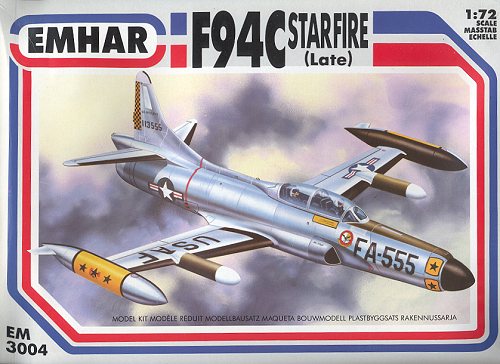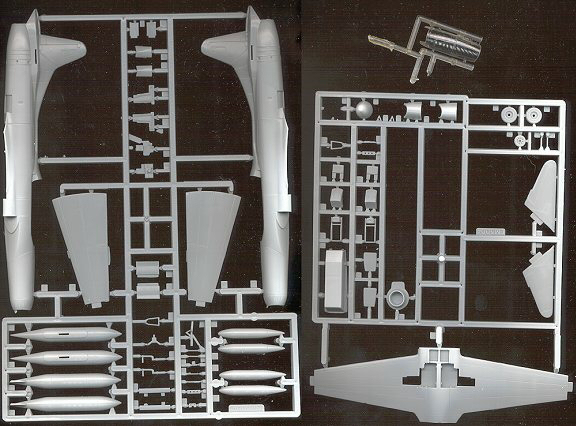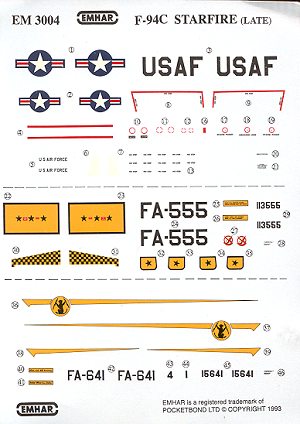
| KIT: | Emhar 1/72 F-94C Starfire |
| KIT # | EM 3004 |
| PRICE: | $12.98 |
| DECALS: | Two Aircraft |
| REVIEW & | |
| NOTES: | ` |

| HISTORY |
In the late 1940s, the USAF realized that it neededdedicated all weather interceptors to counter what was seen as a realthreat of attack by Soviet bombers. With the successful detonation of a nuclearbomb by the USSR, this need was seen as even more urgent. There were severaldesigns on the board and in prototype stage that looked quite promising, butsomething was needed to replace the prop driven P-61. This came in the form ofthe F-94A, itself basically an afterburning version of the T-33 Shooting Starjet trainer.
The F-94A and B versions relied on guns as the main offensiveweapon and did manage to shoot down a few planes in Korea, though mostly slownuisance raiders like the Po-2 biplane. During this time frame, it was seen thatrockets were what was really needed to bring down a large Soviet bomber. TheGermans in the last weeks of WWII had deployed unguided rockets, the R4M, with devastatingsuccess in the few instances that they were employed, so it was decided toupgrade the F-94 to carry these weapons.
Pods on the leading edge of the wings as well as build innose-mounted rocket bays were designed into the F-94C. Along the way, animproved radar system and empennage were developed for the aircraft. Like manyfighters of the 50's, its actual service life was relatively short as moreimproved aircraft were rapidly being developed. Unlike the F-94B models, noF-94Cs were passed on to Air National Guard units.
| THE KIT |

 Emhar's kit of the F-94C is noweight years old. It is molded in flash free grey plastic with engraved panellines. In many ways, it is quite reminiscent of an improved Frog kit in that itis relatively basic and appears to be pretty easy to build. There are nooptional parts other than decals. Parts in general are good, though it isobvious that you are not buying a Hasegawa kit. The cockpit has a tub, twoinstrument panels and two seats that are themselves a five-piece construct.
Emhar's kit of the F-94C is noweight years old. It is molded in flash free grey plastic with engraved panellines. In many ways, it is quite reminiscent of an improved Frog kit in that itis relatively basic and appears to be pretty easy to build. There are nooptional parts other than decals. Parts in general are good, though it isobvious that you are not buying a Hasegawa kit. The cockpit has a tub, twoinstrument panels and two seats that are themselves a five-piece construct.
Thereis no intake or exhaust trunking, but the intakes should fit well and there is ablanking plate with a compressor face on it for the exhaust. There are nomarkings on the wings showing where the rocket pods are to be attached, but theinstructions show them to be 45mm out from the fuselage. There are four speedbrakes that you can display open or closed. I suggest finding images to see ifthese are normally open on the ground or not. The thick plastic canopy can bedisplayed open or close. Mine came without a windscreen and several letters toEmhar did not result in a replacement. Fortunately a very kind reader sent me anew clear sprue and I am most grateful for his kindness.
Theinstructions are a single folded sheet and adequate for construction of the kit.There are 8 construction steps that show a logical building sequence. There isno indication that any nose weight is needed, but I'd play it safe and installsome. On the other side of the sheet is a brief history in four languages and adecal placement chart. You have options for two aircraft. The box art bird isfrom the 27th FIS at Wright-Patterson AFB in 1955. The 27th currently fliesF-15C Eagles from Langley AFB. The other is the 84th FIS from 1954. The 84thwent on to fly other interceptor types including the F-106A and ended its USAFexistence in 1985 flying T-33s! The decals are a bit thick, glossy and havelarge areas of carrier film. By all accounts, they work quite well, though I'dbe wanting to replace the rather oddly shaped national insignia.
Allin all, it doesn't look like a bad kit, but could definitely benefit from anaftermarket set for the cockpit and seats.
Review kit courtesy of me and my wallet!
If you would like your product reviewed fairly and quickly by asite that averages over 2,700 visits a day, please contactme or see other details in the